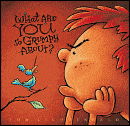I finally have some downtime this holiday weekend - the
Bills game is blacked out, Pittsburgh is losing miserably (WAHOO!!)and my beloved
Sabres don't play until tonight! I use my Friday posts for sharing a book to help in teaching about writing - but I must admit that despite the stack of books on my coffee table to be read, I read mostly sales fliers this weekend!! Not that this is a bad thing - I have all my shopping done, the rest is just icing on the cake!!
Although I shopped and ate my way through most of the weekend, I still had some time to reflect on writing. (Sad, I know, but it is my passion!) I've been thinking a great deal about the "new literacies" of the Web 2.0 and the possibilities that it holds for education. I have specifically
not posted on this topic on this blog because I maintain another (Grand Rounds) with a colleague for that type of thing. But the lines have started to cross...
I began blogging as a way to create a community of learners around teaching writing. I have the honor of facilitating many workshops on writing in our region and I say honor most sincerely. I am passionate about teaching writing and the power of writing and am grateful to the teachers who spend time with me reflecting on and investigating their own writing practice. My hope is to continue that learning via this blog, long after the designated day of my visit has passed. I believe that we must be learners if we are to teach - otherwise, we are not good models for our students.
But a recent
post by Will Richardson has me thinking. Will writes about a discussion with a high school English teacher who has begun to use Web 2.0 tools in the classroom:
We talked at some length as to whether reading for our students is much different than reading was to us. Whether they are reading in different ways, specifically through video or other media, and whether those reading literacies are equally as important as text literacy. Whether we are just chained to our old definitions of what reading should be because that’s how we’ve experienced it. Whether now that we can connect to so many different texts we shouldn’t be surprised that most students find Of Mice and Men irrelevant and uninteresting. Whether we should be rethinking what reading literacy means.
WOW!! It brings me back to an inservice day in my district where I led a group of teachers to investigate what literacy means in their content area. You see - I believe that each content area has it's own literacy components, that to simply teach a student to read or to write means nothing if we don't expose them to multiple types of text. Classic literature, graphic novels, technical writing, primary sources - all contain words but to decipher their meaning takes a bit of a different skill. And to emulate that writing - to write like a scientist, a historian, an engineer - those take another set of skills. It is out obligation (or
moral imperative as
Kim Moritz writes about) to teach this literacy to our students in order for them to be successful. But on that inservice day - I was informed by some of the teachers (well, two to be exact!) that students haven't changed in 37 years (i.e. they are lazy.)
I heartily disagree - students have changed tremendously! The students I taught were not the same type of student that I was and I was not the same as my parents. The folks who haven't changed in those 37 years are the teachers - those who believe that some can learn, and some cannot. Those teachers who are there to impart their knowledge, rather than to grow and nurture the knowledge of others. I don't think Of Mice and Men is irrelevant or uninteresting in this day and age - but those who are teaching it might be!!
Don't get me wrong - I am not bashing teachers! I am one!! Instead, I think it is time that we open up our doors, see the world that awaits our students, and start preparing them for the future. We don't know exactly what that looks like - but we can at least start using tools from this century!! Lots of folks I talk to lately aren't sure what that looks like, but I recently found
this from a 16 year old student who might help frame it for us(Thank you
think:lab!):
So here is what I am proposing. The way classes are taught should be split into three sections: Teaching of Information and Methods, Thinking, Discussing, and Re-working, and then Producing Content and Spreading your Knowledge to others. In more detail below.
Teaching of Information and Methods
This is what you think of when you think of school. Textbooks, sitting behind desks, taking notes, and being sent home to memorize the information, only to come back and take a test. This is necessary for the next two parts.
Thinking, Discussing, and Re-working
Talking about what you learned. Focusing on current events and news. And looking to the future. This part could have a little unconference feel to it.
Producing Content and Spreading your Knowledge to others.
This is the part that the internet enables. Creating videos, podcasts, blog posts is at the heart of this part of the class. Being able to publish books through LuLu. This allows students to spread knowledge that was learned in the first part and the new ideas that were generated in the second part.
I think Will's right - it's time to rethink literacy....but let's start doing it with kids!
